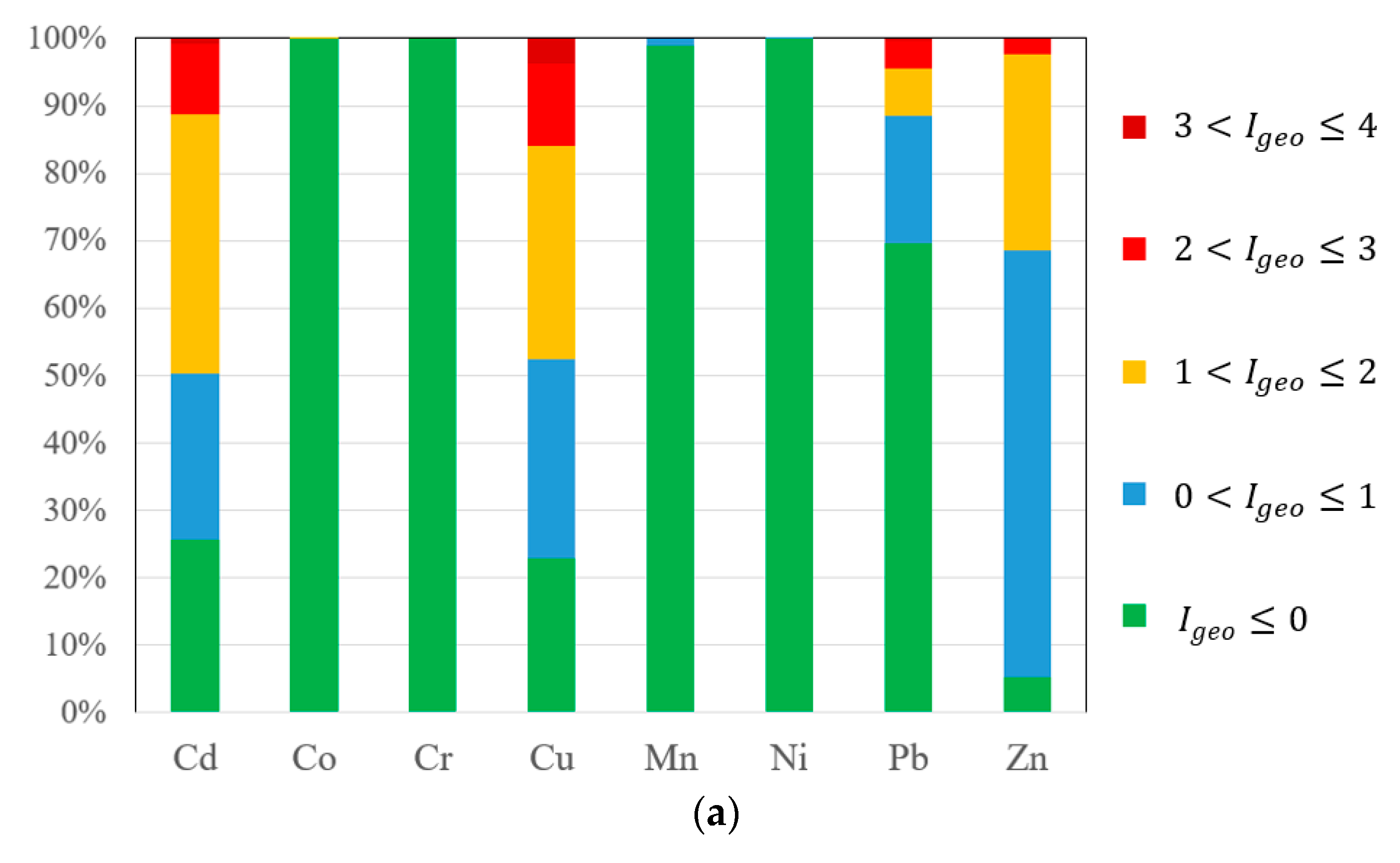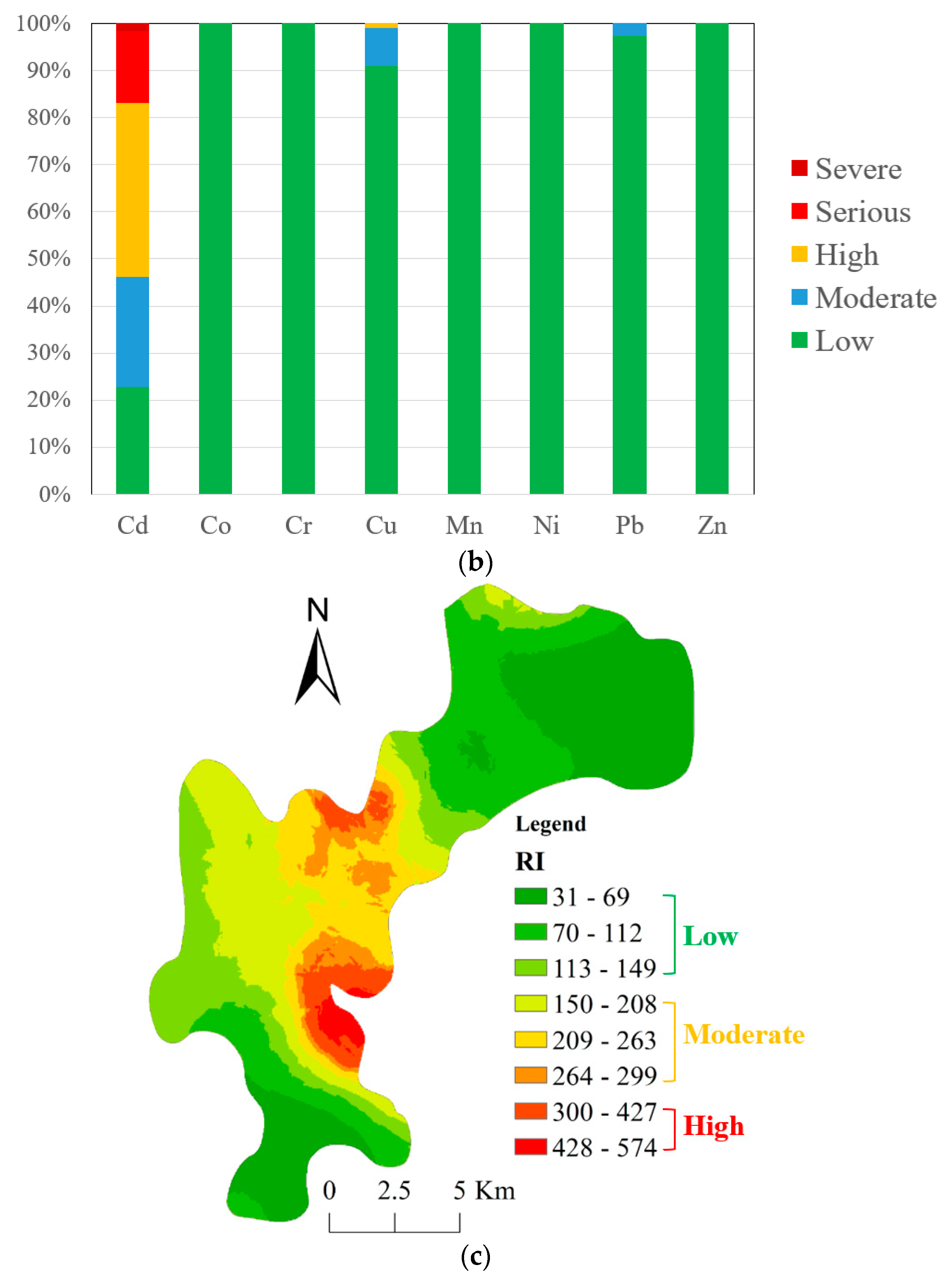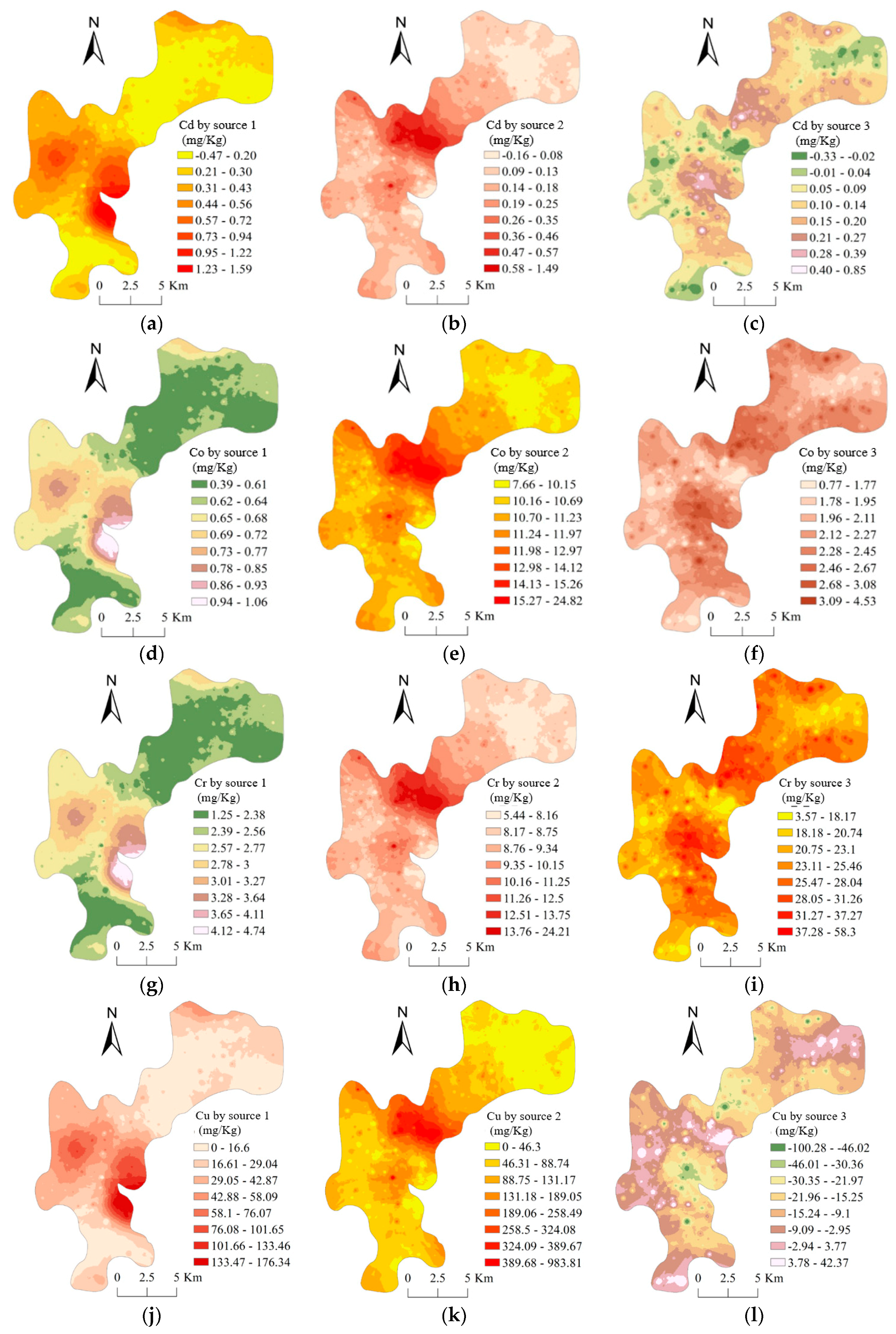3.1. Descriptive Statistics and Spatial Distributions of Soil Heavy Metals
Based on the available samples, the statistical characteristics of the heavy metal concentrations in the Daye region are presented in
Table 2. As shown in
Table 2, the percentage of sampling points where the concentration exceeds the background (PbB) was greater than 50% for Cd, Cu, Pb, and Zn, indicating serious Cd, Cu, Pb, and Zn pollution in the study area. On the other hand, although the mean concentrations of Co and Mn were less than their background values, their PbB values exceeded 30%, indicating that part of the study area was polluted by these two heavy metals.
The heavy metals in soils were also studied in different mines in China. As shown in
Table 3, the concentration distribution patterns of Cd in this study were similar to the values found in the Nandan County, which is located in the north of the Guangxi province as a mining town [
29]. However, the mean concentration of Cd was much lower than those reported from some large lead-zinc mining areas, such as the lead-zinc mine in Qixiashang of Nanjing city with a mean of 17.56 mg/kg [
30], and the lead-zinc mine with a mean of 15.56 mg/kg in the Lanping county, Yunnan province, China [
31]. Compared to soil from other mining areas, the mean value of Cu in Daye soils was markedly three to six times higher than the values reported in other urban soils [
8,
31,
32,
33,
34]. However, the mean value of Cu was still lower than the value in soils of the mining area in Nanjing city [
30,
35]. The measured mean values of Mn, Pb, and Zn were extremely higher in the soils of lead-zinc or Mn mining areas than the values presented in this study. For example, the mean concentrations of Mn, Pb, and Zn were 14015.31 mg/kg, 2232.16 mg/kg, and 5201.86 mg/kg, respectively, in the soils of the lead-zinc mine of Nanjing city [
35]. The mean values of Pb and Zn were 1093.03 mg/kg and 867.08 mg/kg, respectively, in the soils of a lead-zinc mine in the Guangdong province [
10]. The mean concentrations of Mn, Pb, and Zn were 8853.21 mg/kg, 1211.29 mg/kg, and 685.36 mg/kg, respectively, in a Mn mine in Xiangtan city, Hunan province [
36]. According to the comparisons above, the mean concentration of Cu in soils was higher than most of the other mining areas in China. However, the concentrations of Cd, Mn, Pb, and Zn were lower than other mining areas, especially lead-zinc mines, in China. Thus, the concentrations of heavy metals in soils may be closely related to the local mineral type.
The Pearson’s correlation coefficients between the concentrations of heavy metals in soils based on sampling points are summarized in
Table 4. The concentration of Cd, Mn, Pb, and Zn showed a high significant positive relationship with each other, which may suggest a common origin. The correlation coefficient between Cu and Co is 0.62, indicating a common source. Additionally, the correlation coefficient between Cu and Co is 0.51, also suggesting a common origin. Furthermore, although there are some other significant positive relationships, such as Cr and Cd, Mn and Cr, Zn and Co, and so on, the correlation coefficients between them are not high. Thus, the results of the correlation analysis based on the sampling points cannot clearly indicate the sources of pollution.
The spatial distributions of the Cd, Co, Cr, Cu, Mn, Ni, Pb, and Zn concentrations in the study area are presented in
Figure 2. To intuitively understand the severity of the heavy metal pollution levels in the soil of the Daye region, in the maps of
Figure 2, the yellow, blue, and red colors represent heavy metal concentrations that are close to, lower than, and higher than their background values, respectively. As shown in
Figure 2, the maps of the Cd, Cu, Pb, and Zn distributions are almost entirely covered with red and yellow colors, indicating that the concentrations of these four heavy metals were higher than their background values over almost the entire study region. Regarding the Cr and Ni maps, most of the study region was covered in blue, indicating that only a small part of the region was polluted with Cr and Ni. Based on the Co and Mn maps, it was concluded that nearly half of the study region was polluted with these elements. Furthermore, the spatial distribution patterns of all heavy metals were characterized by decreasing concentrations from the central and southeastern parts toward the southern and northern parts. These concentrations peaked in the central and southeastern part, which may be related to the mining and smelting operations in that region (see
Figure 1).
Table 5 summarizes the cross-validation results for the spatial distributions of heavy metal concentrations obtained by OK interpolation. These results show that the
r and ER values of the eight heavy metal concentrations ranged from 0.75 to 0.99 (
p < 0.01) and from 4.75% to 18.42%, respectively, indicating high spatial interpolation accuracy (note the high
r and low ER values). Hence, the spatial interpolation results were valuable for subsequent analyses.
3.2. Pollution and Ecological Risk Assessment
Obviously, the spatial
distribution pattern of each heavy metal is similar to the spatial pattern of the corresponding heavy metal distribution in soils, as shown in
Figure 2. Therefore, it is not necessary to present the
for each heavy metal spatial distribution here. According to the quantitative
results for the eight heavy metals (
Figure 3), 74.23%, 77.16%, 30.46%, and 94.62% of the study area was contaminated by Cd, Cu, Pb, and Zn, respectively, at various pollution levels. Approximately 0.90%, 3.82%, and 0.44% of the study area was heavily contaminated by Cd, Cu, and Pb, respectively. Additionally, approximately 38.40%, 31.72%, 6.86%, and 29.09% of the study area was moderately contaminated by Cd, Cu, Pb, and Zn, respectively. These findings demonstrate that the soils of the study area were partially seriously polluted by some heavy metals (e.g., Cd, Cu, Pb, and Zn).
As shown in
Figure 3b, Cd posed a moderate, high, serious, and severe potential ecological risk in approximately 23.30%, 36.80%, 15.39%, and 1.59% of the study area, respectively, whereas almost all of the study area was free from ecological risk posed by other heavy metals, especially Co, Cr, Mn, Ni, and Zn. Thus, it can be concluded that the potential ecological hazard due to heavy metals in Daye soils was mostly derived from the accumulation of Cd. As presented in
Figure 3c, the RI values exceeded 150 throughout the central part of the study area. The spatial distribution pattern of the RI was similar to the pattern of Cd, indicating that the potential ecological hazard due to soil heavy metals was mainly related to Cd in Daye City.
3.3. Source Identification and Apportionment By PCA/APCS
The PCA results obtained by applying varimax rotation to the concentrations of heavy metals in the soil are shown in
Table 6. Three principal components (PCs) with eigenvalues higher than 1 (before and after rotation) were extracted; PCA led to a reduction in the initial dimension of the dataset to three components that explain 87.21% of the data variation. The first PC (PC1) explains 38.98% of the total variance and with high loadings for Cd, Mn, Zn, and Pb. As shown in
Figure 2, the hot spots of Cd, Mn, Zn, and Pb were all located in the southeastern part of the study area, where many mines and smelters of gold, silver, copper, iron, molybdenum, and sulfur, among other minerals, are located. Thus, PC1 can be considered a source of mineral exploitation and smelting involving a variety of minerals (ES_M). The second PC (PC2), dominated by Co and Cu and moderately by Cd, accounts for 25.74% of the total variance. As shown in
Figure 2, the concentrations of Co and Cu have similar spatial distribution patterns characterized by an increasing accumulation from the north and south to the center of the study area. The only hot spot is located in the central part of the study area, where the oldest in-use copper mine (Tonglu Mountain Copper Mine) in China, with related tailings and smelters, is located. Cobalt (Co) resources are mostly associated with copper deposits. Thus, PC2 is mainly related to the mining exploitation and smelting of copper ore (ES_C). The third PC (PC3) is strongly correlated with Cr and Ni. The concentrations of Cr and Ni were lower than or approximately equal to their background values in Hubei soil, indicating that these elements mainly originate from natural sources.
Next, the APCS receptor model was applied to the three extracted components to quantify the contributions of the sources to each spatial grid. SPSS software was used to develop suitable programs and outputs for carrying out the apportionment procedure. The results of the statistical analysis are presented in
Table 7. The high values of R
2 for all heavy metals demonstrate that the source apportionment results meet the modeling requirements.
Figure 4 shows the spatial distributions of various heavy metal concentrations that resulted from the three major sources. Notably, in the results of the source apportionment based on APCS, the source contribution estimates are not constrained to be non-negative [
26,
37,
38]. Thus, the negative values in the results of the APCS source apportionment, including the negative values in
Figure 4, indicate relatively small contributions. Furthermore, the contributions from non-specified sources (the forth to eighth components in
Table 6) were negligible because the estimated values of
in Equation (5) were usually very small. Based on the percentage of individual heavy metals apportioned to each source (
Table 7), the fraction of the contribution of each source to the total heavy metal concentration in soils was estimated (see the last line in
Table 7).
According to the results in
Table 7 and
Figure 4, in Daye City, ES_M accounted for an average of 51.97%, 82.69%, 70.95%, and 69.83% of Cd, Mn, Pb, and Zn, respectively. The high contributions made by the ES_M source were located in the western and southeastern parts of the study area, where various kinds of mines and smelters are distributed. The ES_M source contributed 69.21% of the total soil heavy metals in the study area. Therefore, ES_M is the largest source of soil heavy metal pollution in Daye. On the other hand, ES_C accounted for an average of 79.65% and 83.4% of the Co and Cu, respectively. The hotspots of the contributions by ES_C are located in the western and central parts of the study area, which have a long history of copper mining and related smelting enterprises. This again indicates that the second greatest source of heavy metal pollution was directly related to the mining and smelting of copper.
Meanwhile, as is shown in
Figure 4, the high contributions for all heavy metals by source 1 and source 2 were located in or around the mines and smelters (also refer to the spatial distributions of land cover in
Figure 1). It is worth noting that there are the same spatial distribution patterns of contribution maps for all heavy metals from the same source. For example,
Figure 4a,d,g,j,m,p,s,v shows spatial distributions of the various heavy metals’ concentrations contributed by ES_M. Those maps clearly point out three locations of ES_M sources (the north, west, and southeast parts of the study area) and four kinds of heavy metals mainly contributed by the ES_M source (Cd, Mn, Pb, and Zn). Similarly,
Figure 4b,e,h,k,n,q,t,w indicates that ES_C is located in the center of the study area, and it is mainly responsible for the accumulations of Cu and Co. In addition, as is shown in
Figure 4j, ES_M also contributed Cu to the soil. In addition, a part of Cd, Mn, and Zn in the soils were contributed by ES_C, as shown in
Figure 4b,q,w; thus, the contribution maps of the identified sources of heavy metals might be a powerful tool to analyze the land covers that contaminate surrounding soils.











